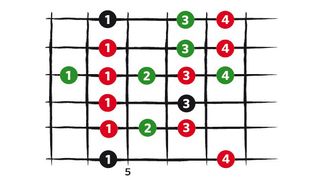
I chose G because it lines up well on the guitar. I’m going to choose the key of G for today’s examples. The best way to get started with this idea is to relate patterns. It’s a good bit of notes and without a method, very hard to make that scale sound good. We are going to use that, but before we do, take a look at it and see what I mean. I have also combined them both in the last column. It’s a great way to visualize where both scale patterns fit together. On the sheet below, I have put the Major and minor pentatonic scales that fall in the same areas together for you. It is easy to lose the guide notes, the chord tones. Giving you the tendency to land on too many weak notes and sound sour. It is also tough wrap your head around because these type of blended scales make it hard to distinguish between the stronger and weaker notes. Maybe over time you will be able to handle that kind of thought, but in the beginning, there is just too many notes to wrap your head around. Just combining all of the notes of both scales and making a new SUPER scale is not the best way to do it. So getting started with mixing the Major and minor pentatonic, it’s easy to start off on the wrong foot. The more familiar you are the cooler they sound. When you are unsure about these new sounds they tend to sound unsure. If you start using these examples and they don’t sound great at first… give them some time. So, let’s realize this in advance of what we are about to do. This scale tended to sound one way where another sounded another way. It was open, There were no rules, just tendencies. It seemed like I could playing anything over one if I played it with confidence… attitude. The more confident I was the better it sounded. And guess what: this worked too!Īnd the farther out I went, the more the 7th chord could take. I started just waiting for a 7th chord to come around in any style of music I was playing, so I could start using these cool sounds. I played my major pentatonic, minor pentatonic, diminished, and mixolydian scales over it and they all sounded different but great. You could get away with a lot of stuff and still sound good. When I started experimenting over the 7th chord I discovered that it was very forgiving. I was used to the idea that you played major on the major progressions and minor on the minor progressions, and that was that.

This is where I started, on the 7th chord. Let’s get some different sounds today and get our ears used to hearing something different coming out of our amps. There it is: the starting point for moving past the pentatonic cell block. Were going to talk about mixing Major and minor pentatonic scales. And you can use scale patterns that you most likely already know to get started.

So many choices and so many ways to start working on something that you are unsure if you have the skills required to play.īut the entry into this world of blending sounds is not as difficult as you think. There are ways to outline chords and even ways to outline chords that aren’t even playing at the time. There are many techniques that get away from the main scale for a bit to great effect. What is that? Where are these notes coming from? Why do they sound so good? How do I use these sounds in my own playing?

Once you think you have it figured out what scale is used, you find some notes that just don’t fit your scale patterns.

If you have ever tried to transcribe some of these lead lines, you may start to find that they don’t line up perfectly with just one type of scale. These sounds take some of the standard tones we are used to and weave a line that is both complex and pleasing at the same time. You may have heard it in a blues tune or a classic rock, country or bluegrass song. And these notes flow from one feeling to the next without hesitation and take your ear on a sort of journey. They are note choices that seamlessly blend the happy, sad, angry, and sweet sounds that we enjoy. The difference is that the lead player seems to have them all at the same time. It is a collection of notes that takes advantage of all of the different moods and feelings that are common to a style of music. It’s not shocking to the ear, it just pulls at the ear a bit. What is it? What is that sound? That sound that you can’t quite put your finger on?


 0 kommentar(er)
0 kommentar(er)
